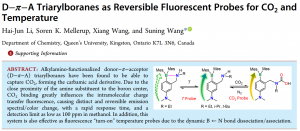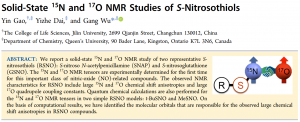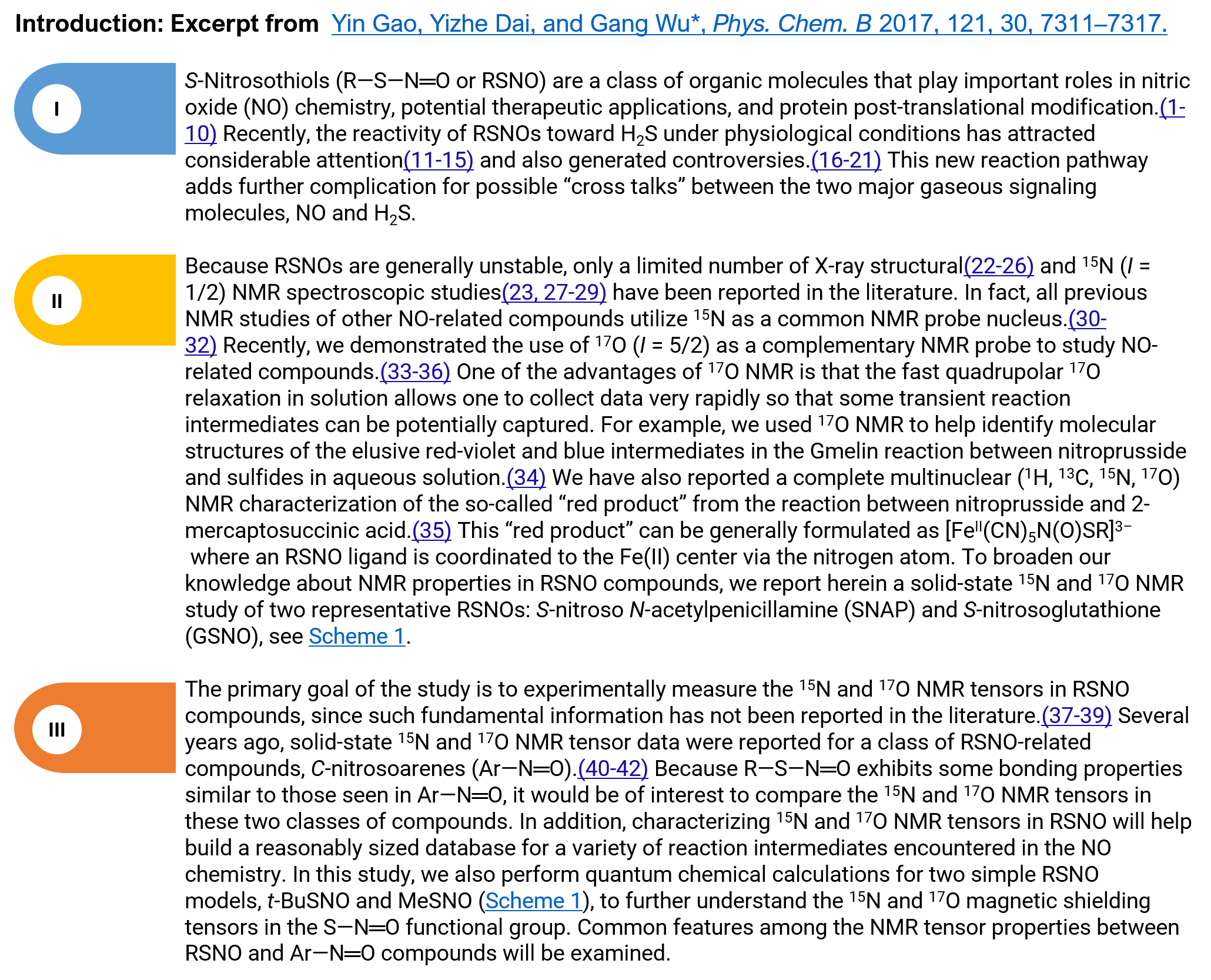5 Journal Articles
Read time: 12 minutes
Overview
This chapter will outline writing structures, styles, and tips related specifically to journal articles.
Sections in this chapter
- Choosing where to publish
- Peer review
- Manuscript Types
- Structure of an article
- Form and Tense
- Tips for each section
- Reviews
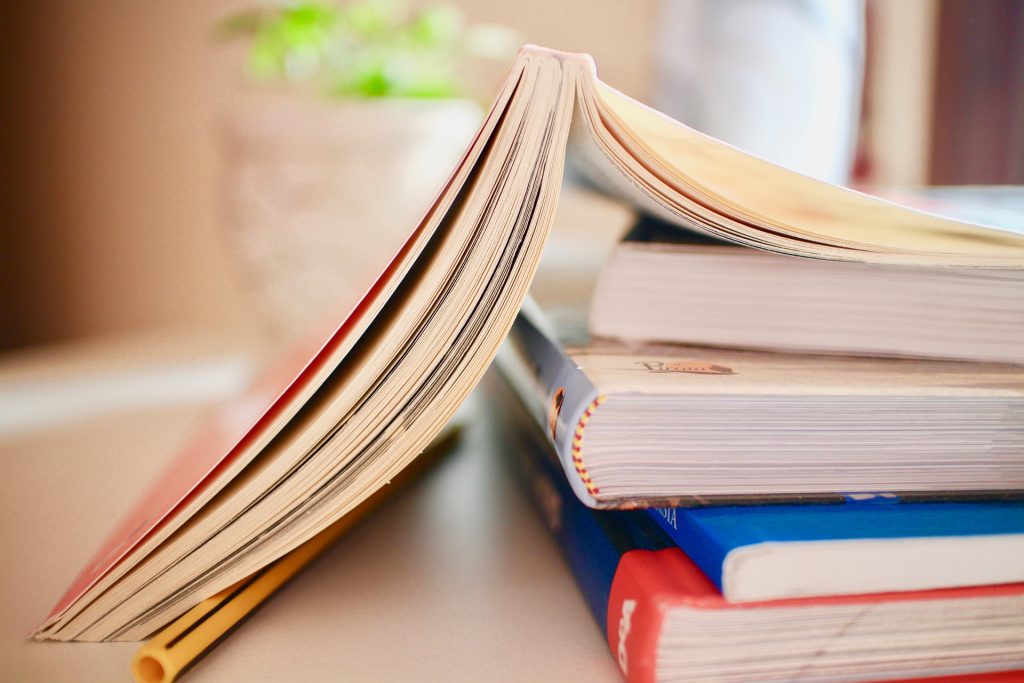
Choosing where to publish
Choosing which journal to publish your research in relates back to the audience of your research. Big discoveries that will have influence across science are published in broad readership journals like Nature or Science. Research that will have wide-ranging influence in chemistry, and a broad readership across chemistry’s subdisciplines, are published in journals like the Journal of the American Chemical Society. More specialized journals are the right fit for research that has an audience of other experts in the sub-discipline (i.e. organic chemistry, inorganic chemistry, materials, etc.).
Once you choose where to publish, many journals (or the publishers) provide guides and document templates (Click here for the Author Guide to JACS). These guides will provide you with specific formats and structures of articles in that journal. Templates can be useful, but if you are a perfectionist it is best to leave them until you have a final draft! Otherwise, you will focus too much on positioning figures and fixing text styles too early in the process. Some researchers ignore the templates altogether and submit their work as a single column, double spaced, common Word document that is easier to read and review; once the paper is accepted, the editorial office can help put the article into the correct template.
Beware of Predatory Journals
Predatory journals charge a fee to publish but lack credibility. It can be difficult to spot a predatory journal because they have names that look credible (e.g., Journal of Chemistry and Biochemistry), but upon closer inspection, you will see the following indicators:
- Not linked to a credible scholarly society
- Send unsolicited spam emails and invites with no “unsubscribe” button
- Brag about high quality of the journal using fake journal metrics
- Editor-in-chief also edits other journals in a variety of disciplines
- Promise fast publications
- Make it difficult to find information about the journal
Check the website PredatoryJournals.com for an updated list.
Peer review
Scientific works must undergo peer review to be published in a journal. This is a process where other scientists evaluate the work, usually anonymously, for its merit, originality, rigour, and scope. Peer review provides researchers with another perspective on their work.
Where is peer review used?
- Scientific publication
- Grant review
- Tenure and promotion
Editors and Reviewers have to examine manuscripts for evidence of scientific misconduct in the forms of (Hengl and Gould, 2002):
- Gift Authorship – authors who did not contribute to the paper
- Self-plagiarism – publishing essentially the same work in multiple journals
- Plagiarism – using other’s words or ideas without proper credit
- Fabrication – using data not obtained by actual experiments
- Falsification – manipulating data to obtain false conclusions
- Conflict of Interest – obtaining biased results
Reviewers usually have several choices for recommendations on publishing a manuscript (Hengl and Gould, 2002):
- accept for publication as written
- accept after minor revisions
- reconsider after major revisions
- reject
- recommend for submission to another journal
Common reasons for rejection include (Hengl and Gould, 2002):
- The topic is too specific or irrelevant to the journal
- The paper does not offer anything significantly new
- The objectives and conclusions are not clear or connected
- The methods and/or results are unclear, weak, or misleading
- The writing style is unclear, unfocused, or incoherent
- The data is of poor quality due to the study design, sampling, or method
Manuscript types
The structure and length of the writing depend on the manuscript type. Manuscripts can have several formats:
- Communications: Short (2-page) articles of recent discoveries that need to be published quickly. Must be very concise! [template]
- Articles: Longer and detailed description of a finished project, describing detailed methods and scope. May expand on findings from a Communication if providing new insights and breakthroughs.
- Reviews: Comprehensive and critical review of a specific topic or subfield that compiles literature and reflects on the past and future. Typically long (10-50 pages). These articles do not contain original research but serve the community as a historical record and time-saver for new researchers.
- Perspectives: Are personal reviews of a field or topic that are not meant to be comprehensive.
Structure of an article
Scientific research articles follow the “IMRAD” format: Introduction, Methods, Results, and Discussion. See Table 8.1 below for the structure and parts of a typical scientific paper. Tables and Figures (with captions) are included without the Body and Supplementary Materials.
Table 8.1 Parts of a scientific paper
| Title | Front Matter |
| List of authors and addresses | |
| Abstract (text and graphics) | |
| Keywords | |
| Introduction | Body |
| Methods and Materials (Experimental) | |
| Results | |
| Discussion | |
| Conclusions | |
| Acknowledgements | End Matter |
| References and Notes | |
| Supplementary Materials |
Consider the reader’s view
It’s rare that someone will sit down and read through your whole article. Typically, readers will skim for important information and only read into the details if necessary.
So what does a typical reader read, and in what order?
- Title and author list
- Abstract ( and keywords)
- Figures and their captions
- Skims text and section headings
- Conclusions
- Equations
- Portions of the main text in more detail
Devote extra time to crafting the title, abstract, figures, and headings!
Form and Tense
Knowing whether to write in the present or past tense can be tricky and depends on the context and section of the article (See Table 8.2). The most important thing is to be consistent. In your editing and final proof of your article, do a read-through to check that you are consistently writing in the same tense, at least within each article section.
Table 8.2. Typical writing tense in different sections of an article, with examples.[1]
| Abstract Past tense (when referring to your own work)Present tense (when describing context) |
“This resolution was accomplished using a Brønsted acid catalyst”
“Azomethine imines are valuable substrates in asymmetric catalysis” |
| Introduction Past or present tense |
“These versatile compounds are well known as substrates in 1,3-dipolar cycloadditions and nucleophilic additions”
“Since this report, there have been many examples of catalytic stereoselective reactions with N,N’-cyclic azomethine imines” |
| Materials and Methods Past tense (your own procedures) |
“The ee value was determined by HPLC using a Diacel ChiralPak AD-H column.” |
| Results and Discussion Past or present tense |
“Bulky alkyl- and naphthyl-substituted azomethine imines were less reactive”
“The binding mode of these catalysts is unique” |
| Conclusion Past or present tense |
“In summary, we developed a kinetic resolution …”
“This protocol demonstrates the first example of stereoselective reduction of azomethine imines” |
Tips for Articles by Section
Title
Review the chapter on Style and write your title to be clear and descriptive, without being too wordy or too vague. Omit the starting “The” and avoid abbreviations and jargon. Avoid using these redundant phrases:
- On the
- A study of
- Research on
- Use of
- Report on
Also, be on the lookout for misplaced modifiers! In the following title, does the detection use azine dyes or do the sponges contain the dyes?
“Detection of Natural Products from Sponges with Azine Dyes”
Authors
Authors are listed who contributed significant work, data, and writing to the research article. In Chemistry, the first author is usually a graduate student or postdoctoral fellow to did the bulk of the work. The last author is usually the research supervisor (Professor) who also serves as the corresponding author (*). Other authors are listed by contribution or alphabetically. Be aware that you will see different formats or author orders based on the field or personal preference of the corresponding author.
A.B. Smith, R.J. WIlson, P.E. Adams, C.D. Jones*
* cdjones@university.ca
Abstract
The abstract for your article needs to be a concise summary that also draws in your audience to read the rest of the article. It should stand alone and highlight only the most important aspects of the article. The “10% in 10 minutes” activity is a great way to shorten an abstract that is too long-winded. It is best to write the abstract at the very end, one the rest of the paper is finished.
Follow this sentence-by-sentence manual from Julia Eckhoff, Associate Editor at Springer Nature, to writing an abstract.
Most journals also have graphical abstracts that are included with the text. These range from simple schemes to elaborate works of art, and from low to high quality. For examples of interesting or funny abstracts, and some examples of what not to do, check out the TOCROFL blog.
Two excellent examples of abstracts and graphical abstracts from Queen’s Chemistry
Keywords
Some journals require a list of 5-10 keywords or phrases for each article. Choose these carefully by thinking of how you want your article indexed by the search feature and to be aligned with your title and abstract. See this tutorial from Springer for more tips and examples.
Introduction
The introduction of an article introduces the topic, situates the work within current knowledge, and indicates a gap that the research addresses. This section thus starts broadly and then focuses in on specific research questions and objectives, which should be stated clearly at the end of the introduction.
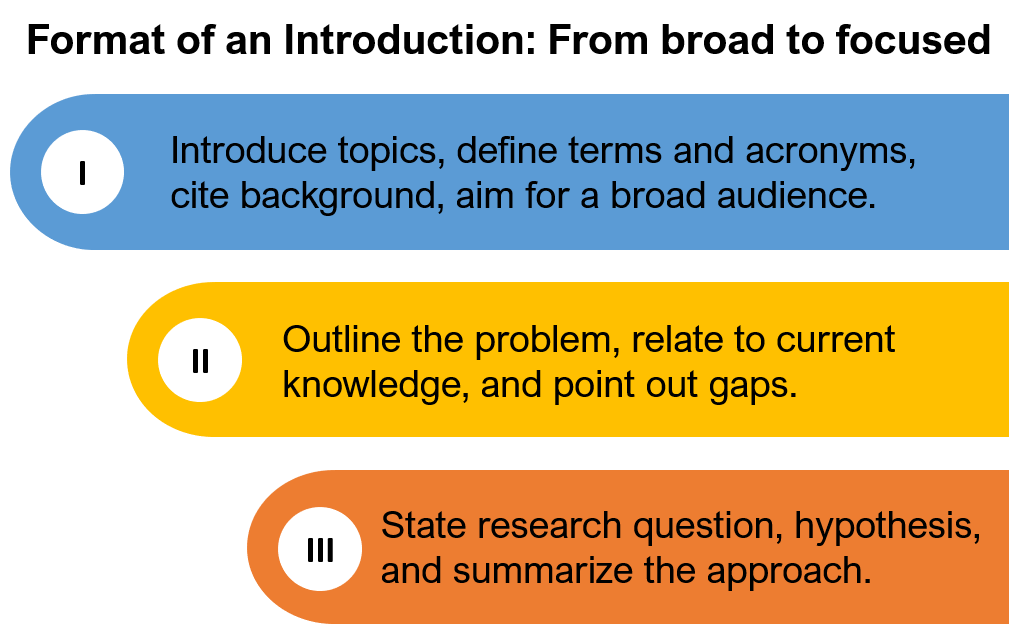
Your introduction will need a brief but thorough description of prior research in the area, and it is imperative to cite the important and relevant background articles. If your introduction is getting too long due to an extensive literature review, consider if you can cite fewer articles or cite a review that helps readers find more information. If you can’t remove any references, create a separate ‘Literature Review’ subsection.
Experimental (Materials and Methods)
The experimental section is usually divided into two sections, Materials and Methods. In some journals or formats (communications, full articles), the bulk of this section is included in the body, in others, it may be in the Appendix or Supplementary Materials.
A tenet of science is reproducibility, and the experimental section of an article must provide sufficient details for replication of the findings. What good is your great new chemistry if no one else can use it? For this reason, this is the most important section to check your grammar and use concise language.
Read articles in the journals related to your subfield to see what types of things should be included. In many articles, there should be details of chemical suppliers, how reactions were performed, and characterization of all new compounds to prove purity (elemental analysis, spectroscopy, X-ray diffraction). In theoretical articles information on computational and mathematical details should be included. Make sure to cite literature for any standard methods.
Results
The Results section is the core of the paper, containing all the experimental data and findings in full. Many articles include a separate section for Results, or this information is combined with the Discussion. Tables and Figures are used for most data, especially if they cannot be simply presented in written form (remember: most readers will skim your paper and only look at the Figures). Present your results systematically and cross-reference all tables and figures in the text.
This section is organized according to major topics or experiments that were conducted, with descriptive subheadings. Make it easy for the reader by writing your subheading as a summary of the result.
Common mistakes
1. Interpreting results rather than reporting
- The results should only contain observations and measurements.
- Results become part of a permanent store of information, while their interpretation can change with time.
2. Tense
- Any focus on past actions requires the past tense. “The yield for this reaction was 80%”
- Use the present tense when referring to tables and figures in the paper. “As we show in Table 1, the yield for this reaction was 80%”
3. Forgetting to integrate Figures and Tables into the text
- The results section should have some text that highlights important results while cross-referencing the Figures and Tables.
- Example: “The V(III) complex 2 (Figure 5) displays a rich spectrum with an intense band …” rather than “Figure 5 displays the optical spectrum of 2 in acetonitrile.”, which merely restates the figure caption.
Text, Table, or Figure?
How should you present your data to the reader? This question takes consideration of the audience, manuscript type, and the type of data. Read Module 2 for more information on this topic. In any case, Figures or Tables should always be presented as close as possible to the related text and cross-referenced. Tables should have concise and descriptive titles. Figure captions should stand alone in explaining what the figure shows.
Discussion
In the Discussion section, the authors must interpret their results by relating the findings to earlier results in the field. This section should be written confidently without making sweeping or exaggerated statements. Discuss the theoretical implications of your work, as well as any practical applications.
Suggestions for the discussion:
- state your conclusions as clearly as possible
- summarize your evidence for each conclusion
- do not try and explain every little detail or limitation
- it’s okay to have some unexpected results
- claims should be supported by the data (do not exaggerate)
- avoid hedging (“Could be”, “Possibly”, “Maybe”)
The structure of the Discussion is important for the flow of your paper. Start by restating and answering your research questions; this can be done in the Topic Sentences within the paragraphs and by using descriptive subheadings like in the Results section. Continue by supporting these answer statements with your results and data, and explain how the findings relate to your original hypothesis. Aim for an answer to the question: What does it all mean? Compare and contrast your findings to prior work and discuss discrepancies. Briefly describe both limitations in your approach and what the findings might suggest for future studies.

Common Discussion mistakes:
- New results are discussed
- Overly broad statements
- Errors when interpreting inconclusive results
- Ambiguous data sources
- Missing information
- Wrong verb tense
Conclusions
The Conclusions are the shortest part of the article. Briefly summarize the key findings and answers to the research questions, without just repeating the Results section. Often authors will add a new, higher level of analysis. Most importantly, the conclusion should explicitly state the significance of the work.
Some readers will skip straight to the Conclusions if an Abstract is too long! Save writing the conclusion until you have a good draft of the rest of the manuscript so that you can easily write about the “big picture”.
Acknowledgements
This is the section to acknowledge any funding or technical supports, or “fruitful conversations” with colleagues.
References
Check the journal’s or publisher’s referencing style and follow it! Use a citation manager, like EndNote or Mendeley, that allows you to create a list of references in many formats. Make sure to be consistent and do a thorough check of author names, page numbers, etc. before submitting your article. Queen’s University has compiled many resources into this Citation Guide.
Supplementary Materials (or Appendix)
This section is a separate document (or if an Appendix, is at the end of the manuscript), and contains extra experimental details (e.g., NMR spectra). Pages are numbered S1, S2, S3… and Figure captions and Table titles are also numbered this way (Figure S1) to distinguish them from the manuscript. Supplementary Materials can also include other file types like X-ray crystallographic datafiles, videos, 3-dimensional models, or anything else.
Tips for Reviews
The main difference between an article and a review is primarily the audience. While articles and communications have a specialized audience, the readership of reviews is broader and may cover several subjects. In this way, writing a review is similar to writing a thesis.
The best advice for writing a Review is to start with an outline, which is often included as a Table of Contents at the start of the paper. The outline will help you stay on track with the goal of the Review.
- Bongers, A., Moon, P. J., Beauchemin, A. M. ACIE 2012 54 15516-15519 ↵

